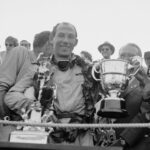The winner of 16 grands prix, the Mille Miglia, Targa Florio and Sebring 12 Hours had continued to race in historic events until the age of 81.
A spell of ill health brought his retirement from public life in 2018.
Tributes have poured in from the world of motor sport. Sir Jackie Stewart said that Moss was his “ultimate hero”.
“He was the most dynamic, the most charismatic racing driver I think that there has ever been,” he said. “The passing of Stirling Moss is an enormous loss to the world of motor sport”
Lewis Hamilton said that he would miss the conversations that he had with Moss. “It was such an unusual pairing, our friendship,” he said. “Two people from massively different times and backgrounds but we clicked and ultimately found that the love for racing we both shared made us comrades.”
https://www.instagram.com/p/B-4dzZjArkj/?utm_source=ig_web_copy_link
David Coulthard, President of the British Racing Drivers’ Club, paid tribute to his “unique and raw talent behind the wheel”, and as well as his loyalty and work for the club.
Moss began his professional racing career in 1950, and gained national fame by winning that year’s Tourist Trophy at Dundrod.
The following year brought his world championship debut and his international breakthrough came in 1954. He began the year by winning the Sebring 12 Hours and ended the campaign as a works Maserati driver.
Moss had entered that year’s Formula 1 season with a privately-bought Maserati 250F and his performances soon attracted official support from the factory. But for a broken oil pipe, he would have likely won that year’s Italian Grand Prix.
He joined Mercedes in 1955 and success quickly followed. His first world championship grand prix was at Aintree, following what Moss described as his greatest victory: his record-breaking Mille Miglia run at an average of 98mph alongside his navigator, Motor Sport’s Denis Jenkinson.
“Sir Stirling was a larger-than-life figure in our sport and one of the survivors of an age when motor racing was about danger, bravery and camaraderie,” said Toto Wolff, the current team principal of the Mercedes team. ”
“Stirling’s career was characterised by an impeccable sportsmanship and in this he truly set himself apart.”
His success in 1955 wasn’t enough to prevent Moss coming second in that year’s F1 world championship, which began a four-year run runners-up finishes. The most notable of these was in 1958 when Mike Hawthorn won the title by a single point.
It was a title that Hawthorn only held because Moss had helped him to avoid disqualification for rejoining the track in the wrong direction at that year’s Portuguese Grand Prix.
By that time, Moss was driving for Vanwall, lured by the thought of winning in a British car. In 1957, he had taken over the car of team-mate Tony Brooks to win at Aintree, the pair sharing in the glory of becoming the first British drivers to win the British Grand Prix in a British car.
In 1959, Moss teamed up with Rob Walker, a friend, first running a Cooper-Climax before switching to a Lotus chassis for 1960 and ’61. The car may have been outdated, but Moss brought it to victory in the 1961 Monaco Grand Prix, with a sensational performance to fend off the V6 Ferraris.
Moss would have moved to Ferrari in 1962 but a severe crash at Goodwood in the 1962 Glover Trophy ended the season before it had begun. He retired the following year.
With a property company and steady demand for personal appearances across the world, Moss maintained a hectic diary well into his 80s, and continued to race in historic events, securing special dispensation from the FIA to wear the same overalls and helmet that he had raced in. He was knighted in 2000.
Motor Sport extends its condolences to the family, friends and fans of Stirling Moss

Sir Stirling Moss
Full career biography and statistics in the Motor Sport Database


